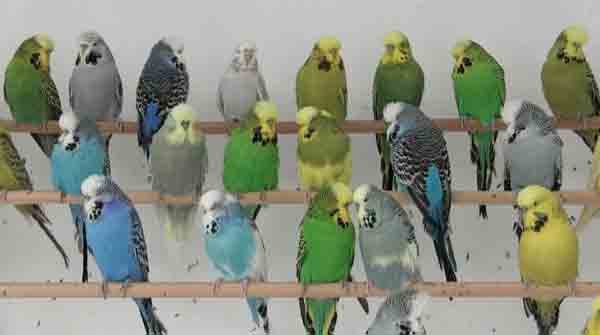

This photograph shows a collection of green, white, blue, and yellow budgies. Photo: Thomas Cooke
Massachusetts, US (BBN) - When it comes to spectacular displays of colour, birds are obvious standouts in the natural world. Many brightly colored birds get their pigments from the foods that they eat, but that's not true of parrots.
Now, researchers reporting a study of familiar pet store parakeets -- also known as budgies -- have new evidence to explain how the birds produce their characteristic yellow, blue, and green feathers, reports ScienceDaily.
The findings reported in the journal Cell on October 5th promise to add an important dimension to evolutionary studies of parrots, say the researchers.
"Budgerigars are a great system for studying parrot colors because artificial selection over the last 150 years has resulted in a large number of simple Mendelian genetic traits that affect color," says first author Thomas Cooke, a graduate student at Stanford University. "We identified an uncharacterised gene in budgerigars that is highly expressed in growing feathers and is capable of synthesising the budgie's yellow pigments."
Scientists have studied colors in budgies for more than a century. They knew that parrots produce psittacofulvins, a type of red to yellow pigment that's not found in any other type of vertebrate. They also knew that an inability to produce yellow pigments in some parakeets turns the birds from yellow and green to blue. But it wasn't clear which genes and biochemical pathways were involved.
To find out in the new study, the team led by Stanford's Carlos Bustamante first used genome-wide association mapping to identify a region containing the blue color mutation. That region contained several genes, so it wasn't yet clear which of them was responsible.
To narrow it down further, the researchers sequenced the DNA of 234 budgies, 105 of which were blue. They also sequenced 15 museum specimens from Australia. Those studies pointed to a single mutated gene (MuPKS) encoding a little-known polyketide synthase enzyme in the blue birds.
In another key experiment, the researchers compared gene expression from feathers of green and yellow versus blue budgies. Those studies showed that MuPKS was highly expressed in birds of both color varieties, but that there was a single amino acid substitution at a conserved residue in the blue budgies.
The researchers next cloned the MuPKS gene and inserted it into yeast to find out if the yeast would begin producing yellow pigments. And they did.
The researchers say it was a surprise to find that a mutation in MuPKS causes such a noticeable color change. That's because similar genes are found in nearly all birds. The difference is that birds outside the parrot family such as chickens and crows don't express the enzyme in their feathers. As a result, they aren't yellow. This discovery suggests the key evolutionary change that led to parrot's brilliant colors was the pattern of gene expression.
"Presumably the gene has some function in non-parrots besides pigmentation, but we don't know what that might be," Cooke said.
Another surprise to the researchers was that the enzyme was most highly expressed in a portion of the feather that dies once the feather is fully formed. It suggests those cells must produce the color and deposit it in neighboring cells before they die.
Color plays an important role in how birds interact with each other, including how they choose mates. The researchers say that as they learn more about how these enzymes are controlled, the findings could be applied to many parrots around the world, from Australia's crimson rosellas to the burrowing parrots of Argentina.
"It would be interesting to see what sorts of changes at the DNA level underlie coloration differences within and between different species of parrots," Cooke said.
The researchers were supported by the National Institutes of Health.
BBN/MMI/ANS